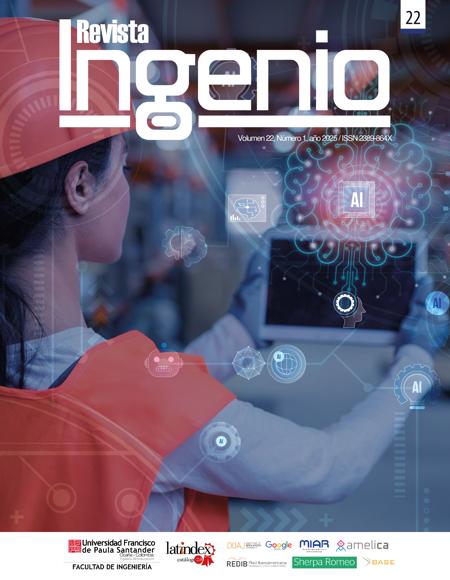The role of emerging digital technologies in instructional design: benefits and challenges
El papel de las tecnologías digitales emergentes en el diseño instruccional: beneficios y desafíos
Main Article Content
During the last few years, the rise of emerging technologies has gained great value and their massification has increased exponentially, mainly during the last decade. These technologies, which are characterized by being disruptive, recent and/or in development, have a great potential for innovation and transformation in all areas where they are present, and the education sector is no stranger to this revolution whose impact is materialized through instructional design. It is relevant to reflect on the role they play in instructional design, approaching an analysis from their benefits and challenges, identifying characteristic aspects of their use and implementation in educational contexts such as the Colombian and motivating to understand the possibilities of modernization in the role of the designer that teachers have, the role of students as active users of these technologies that have a role as mediating tools for learning and that of the government, as normalizer of the new digital ecosystem with the function of formalizing and facilitating the conditions to achieve an effective and sustainable synergy between technology, people and processes.
Downloads
Article Details
UNESCO, “Políticas digitales en educación en América Latina: Tendencias emergentes y perspectivas de futuro,” Instituto Internacional de Planeación de la Educación, Ed., 2022, pp. 1–96.
H. G. Estévez Estévez, M. E. Moyano-Lucio, R. D. Chicaiza-Chimarro, N. N. Correa- Canteral, y J. P. Pallo-Almache, “Reflexiones en torno al impacto de las tecnologías emergentes en la educación: Caso Latinoamérica,” Revista Científica Retos de la Ciencia, vol. 8, no. 18, pp. 1–10, Jul. 2024, doi: https://doi.org/10.53877/rc.8.18.20240701.1
M. Bond, V. I. Marín, C. Dolch, S. Bedenlier, and O. Zawacki-Richter, “Digital transformation in German higher education: student and teacher perceptions and usage of digital media,” International Journal of Educational Technology in Higher Education, vol. 15, no. 1, p. 48, Dec. 2018, doi: https://doi.org/10.1186/s41239-018-0130-1.
D. C. Claros-Perdomo, E. E. Millán-Rojas, y A. P. Gallego-Torres, “Uso de la realidad aumentada, gamificación y m-learning,” Revista Facultad de Ingeniería, vol. 29, no. 54, p. e12264, Oct. 2019, doi: https://doi.org/10.19053/01211129.v29.n54.2020.12264.
L. A. Pérez-Domínguez, “Las principales tecnologías de la era de la industria 5.0,” Revista Ingenio, vol. 21, no. 1, pp. 60–70, Jan. 2024, doi: https://doi.org/10.22463/2011642X.4352.
D. Rotolo, D. Hicks, and B. R. Martin, “What is an emerging technology?,” Res Policy, vol. 44, no. 10, pp. 1827–1843, Dec. 2015, doi: https://doi.org/10.1016/j.respol.2015.06.006
M. Del Carmen, G. Flores Talavera, P. Martínez, B. Universidad, y S. Bolívar, “Cuatro formas de entender la Educación: modelos pedagógicos, conceptualización ordenamiento y construcción teórica,” Educación y Humanismo, vol. 21, no. 36, pp. 137–159, 2019, doi: https://doi.org/10.17081/eduhum.21.36.3147
Neeraj Yadav, “The Impact of Digital Learning on Education,” International Journal of Multidisciplinary Research in Arts, Science and Technology, vol. 2, no. 1, pp. 24–34, Jan. 2024, doi: https://doi.org/10.61778/ijmrast.v2i1.34.
A. Haleem, M. Javaid, M. A. Qadri, and R. Suman, “Understanding the role of digital technologies in education: A review,” Sustainable Operations and Computers, vol. 3, pp. 275–285, 2022, doi: https://doi.org/10.1016/j.susoc
J. E. Márquez Díaz, "Tecnologías emergentes, reto para la educación Superior Colombiana," Ingeniare, no. 23, pp. 35-57, Mar. 2021, doi: https://doi.org/10.18041/1909-2458/ingeniare.2.2882
J. E. Tarazona Suárez, “Generalidades del diseño instruccional,” INVENTUM, vol. 7, no. 12, pp. 37–41, Feb. 2012, doi: 10.26620/uniminuto.inventum.7.12.2012.37- 41.
R. Amaro De Chacín, “LA PLANIFICACIÓN DIDÁCTICA Y EL DISEÑO INSTRUCCIONAL EN AMBIENTES VIRTUALES,” 2011.
G. Veletsianos and S. Houlden, “Radical Flexibility and Relationality as Responses to Education in Times of Crisis,” Postdigital Science and Education, vol. 2, no. 3, pp. 849– 862, Oct. 2020, doi: https://doi.org/10.1007/s42438-020- 00196-3.
Y. Góngora Parra y O. L. Martínez Leyet, “Del diseño instruccional al diseño de aprendizaje con aplicación de las tecnologías,” Education in the Knowledge Society (EKS), vol. 13, no. 3, pp. 342–360, Nov. 2012, doi: https://doi.org/10.14201/eks.9144.
A. Véliz Vega, O. Correa Madrigal, and L. H. Cuba, “Aprendizaje adaptativo basado en Simuladores de Realidad Virtual Adaptive learning based on Virtual Reality Simulators,” Revista Cubana de Ciencias Informáticas, vol. 15, no. 2, 2021, [Online]. Available: http://rcci.uci.cuPág.138- 157Editorial"EdicionesFuturo"https://orcid.or g/0000-0001-7082-9322
M. G. Espinoza Bravo, M. B. Ríos Quiñónez, K. L. Castro Vargas, C. B. Velasco Moyano, and D. A. Feijoo Mendieta, “La influencia de tecnologías emergentes en la educación superior,” LATAM Revista Latinoamericana de Ciencias Sociales y Humanidades, vol. 5, no. 1, Jan. 2024, doi: 10.56712/latam.v5i1.1641.
E. Romero-Riaño, C. J. Galeano-Barrera, I. A. Londoño-Gonzáles, C. D. Guerrero- Santander, y H. E. Martínez-Ardila, “20 años de investigación en desempeño de los sistemas de innovación: un análisis de la estructura conceptual,” Revista Ingenio, vol.
, no. 1, pp. 1–8, Jan. 2022, doi: https://doi.org/10.22463/2011642X.2680.
J. M. Flores-Vivar and F. J. García-Peñalvo, “Reflections on the ethics, potential, and challenges of artificial intelligence in the framework of quality education (SDG4),” Comunicar, vol. 30, no. 74, pp. 35–44, 2023, doi: https://doi.org/10.3916/C74-2023-03.
K. Alhumaid, “Four Ways Technology Has Negatively Changed Education,” Journal of Educational and Social Research, vol. 9, no. 4, pp. 10–20, Oct. 2019, doi: https://doi.org/10.2478/jesr- 2019-0049.
J. Sarango, “Aplicación de la ética en el uso de la tecnología para la educación,” Revista Caribeña de Ciencias Sociales, vol. ISSN: 2254-7630, pp. 1–12, 2018.
K. Cabrera Peña, “Cultura y derechos de propiedad intelectual en la era digital,” Revista de Derecho Uninorte, vol. 60, pp. vi– viii, May 2024,doi: 10.14482/dere.60.190.252.
M. L. Torres-Barreto, J. K. Acosta Medina, y M. Álvarez Melgarejo, “DIDACTIC - Aplicación de la Gamificación y la Inteligencia Artificial en la Educación Virtual,” Revista Innovación y Desarrollo Sostenible, vol. 1, no. 1, pp. 105–112, Nov. 2020, doi: https://doi.org/10.47185/27113760.v1n1.13.




 Perfil Google Scholar
Perfil Google Scholar



